Mao Tse-tung and the Chinese People by Roger Howard

Author:Roger Howard [Howard, Roger]
Language: eng
Format: epub
Tags: Social Science, Regional Studies
ISBN: 9780429802010
Google: KUNvDwAAQBAJ
Publisher: Routledge
Published: 2018-09-18T04:46:42+00:00
7 Filling the Holes and Levelling the Tops
The Third Revolutionary Civil War (the War of Liberation), 1945â1949
The reactionary, backward, decaying classes retained [their] dual nature even in their last life-and-death struggles against the people. On the one hand, they were real tigers; they ate people, ate people by the millions and tens of millions. The cause of the peopleâs struggle went through a period of difficulties and hardships, and along the path there were many twists and turns. To destroy the rule of imperialism, feudalism and bureaucrat-capitalism in China took the Chinese people more than a hundred years and cost them tens of millions of lives before victory in 1949. Look! Were these not living, tigers, iron tigers, real tigers? But in the end they changed into paper tigers, dead tigers, bean-curd tigers.
Mao Tse-tung,
from a speech made on 1 December 1958
The Russian armies cleared the Japanese from Chinaâs northeastern provinces in August 1945. Stalin signed a treaty of friendship and alliance with Chiang Kai-shek while Chiang tried to deny the CCP armies the right to accept the surrender of the Japanese forces in the areas they controlled. Mao went to Chungking and negotiated with Chiang for forty-three days. He secured an agreement that preserved most of the liberated areas as a solid nucleus of peopleâs power.
Scarcely had the provisional agreement between the CCP and the KMT been signed on 10 October 1945 than Chiang resumed fierce attacks on these areas. The United States provided transport to move the KMT armies into the north-east to take power after the Russians withdrew, forestalling takeover by the local CCP units in many places. Mao responded by calling, for the establishment of rural base areas there, independent of the cities the KMT held.
American marines numbering 90,000 landed in Chinaâs northern ports and guarded communications for the KMT. American advisers trained KMT personnel and equipped forty-five of Chiangâs divisions with modern weapons and vehicles. United States aid paid for more than half the KMTâs expenditures. By mid-1946, despite further partial truces, the Third Revolutionary Civil War had begun.
Thus aided, the enemy seemed strong. But âall reactionaries are paper tigersâ, said Mao in August 1946. âFrom a long-term point of view, it is not the reactionaries but the people who are really powerful.â Faced by an enemy whose military supplier possessed the atom bomb, the peopleâs army should take full account of him tactically but despise him strategically, since the outcome of a revolutionary war is finally decided not by the weapons of the ruling class but by the strength of the people. This thesis of Maoâs did much to give the people confidence and turn a negative, defensive civil war into a positive, offensive war of liberation.
Re-organised and renamed the Peopleâs liberation Army (PLA), the communist armies used the method of fighting, set forth by Mao, âconcentrating a superior force to destroy the enemy forces one by oneâ. Despite the KMTâs seizure of big cities, the PL A had within seven months turned the war situation in a direction favourable to the people.
Download
This site does not store any files on its server. We only index and link to content provided by other sites. Please contact the content providers to delete copyright contents if any and email us, we'll remove relevant links or contents immediately.
Down the Drain by Julia Fox(927)
The Light We Carry by Michelle Obama(861)
Cher by Cher(733)
Simple Passion by Annie Ernaux(702)
Love, Pamela by Pamela Anderson(573)
Zen Under Fire by Marianne Elliott(539)
You're That Bitch by Bretman Rock(524)
Novelist as a Vocation by Haruki Murakami(501)
The Foxfire Book of Appalachian Women by Kami Ahrens(500)
Kamala Harris by Chidanand Rajghatta(476)
Alone Together: Sailing Solo to Hawaii and Beyond by Christian Williams(465)
The Nazis Knew My Name by Magda Hellinger & Maya Lee(448)
Gambling Man by Lionel Barber(439)
Drinking Games by Sarah Levy(399)
The Barn by Wright Thompson(390)
A Renaissance of Our Own by Rachel E. Cargle(389)
Memoirs of an Indian Woman by Shudha Mazumdar Geraldine Hancock Forbes(386)
Limitless by Mallory Weggemann(384)
A new method to evaluate the dose-effect relationship of a TCM formula Gegen Qinlian Decoction: âFocusâ mode of integrated biomarkers by unknow(367)
